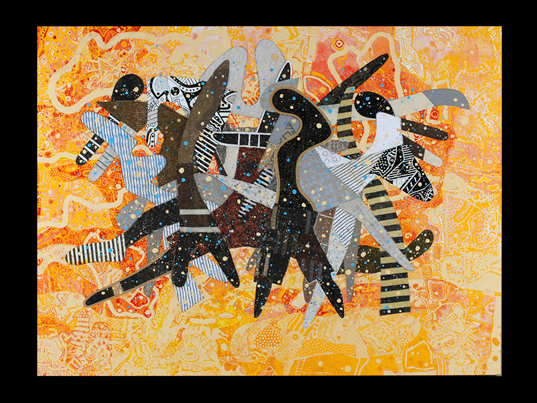Charles McGee exhibit at EMU spotlights an acclaimed, accomplished career

"Celebration" enamel, paper, and fabric collage on dibond by Charles McGee, 2007. On view in "Energy: Charles McGee at Eighty-Five" through December 19, 2009.
Image courtesy Eastern Michigan University Department of Art.
Eastern Michigan University art historian Julia Myers’ McGee retrospective gets it right. The 70-work, career-spanning exhibit at Eastern Michigan University’s Ford Gallery and University Gallery ultimately says it all of this protean talent.
Long recognized as one of Michigan’s most important 20th century artists, McGee’s art indicates he’s not content with mastering a single century. Rather, his career has illustrated the twists and turns of Detroit’s golden age with a determined independence that’s as rare as it imaginative.
Born in 1924 on his grandfather’s sharecropper farm near Clemson, SC, McGee moved to Detroit ten years later, in the midst of the Great Depression — at about the time of the historic “great migration,” when a more than a million southern African Americans followed employment opportunities in the Great Lakes region.
Having not been taught to read or write as a child, McGee took art classes at the Detroit Public Library and he later attended art classes at the Detroit Institute of Arts. But this stage of his education came to an abrupt halt when his mother died and he was obligated to work at a young age.
Yet as Myers’ exhibition catalogue, “Energy: Charles McGee at Eighty-Five” tells us, even this seemingly life-altering reversal ended up being so much grist for McGee’s future art. His foundry work at a Work Projects Administration camp taught him the technical skills he would later use aesthetically.
After 1940s service in the Marines, McGee received formal arts training at Detroit’s Society of Arts and Crafts (now the College for Creative Studies). He taught at Eastern Michigan University from 1969 to 1987, simultaneously operating galleries and showcases between studies abroad while also exhibiting. And still not content to slow down, McGee currently teaches part-time at the Birmingham Bloomfield Art Center.
He’s received numerous prizes and awards, including last year’s inaugural 2008 Kresge Foundation Eminent Artist Award; the 1978 Governor’s Michigan Artist Award; and the 1989 Michigan Artist of the Year Award. His work is in scores of museums nationwide as well as private collections around the world.
When curator Myers was looking at over 250 McGee works of art to organize the Ford and University Gallery exhibitions, she said in a recent interview with the Eastern Echo, “I wanted the different pictures to represent the different phases of his career. I looked for style, quality, and the best pictures during each individual phase of his career.”
This was no small task when it takes into account the fact that the earliest work on display was crafted in 1951, with the most recent being executed earlier this year — that is, a span of nearly 60 years. McGee’s talent crosses historic, cultural, religious, and even (whimsically enough) biological grounds with admirable ease.
Crisscrossing these territories in all kinds of imaginative manners through a dazzling array of mediums, McGee’s only constant has been a clear-eyed optimism whose colorful palettes saturate the viewer’s eye with — yes, a remarkable energy.
Whether working from 1971’s vertically striated geometrically chromatic acrylic on canvas “Color Modules,” to 2008’s biomorphic ultraviolet inkjet spray on dibond relief “Rhapsody in Black and White,” one of the chief characteristics of McGee’s work is his ability to create pulsating visual rhythms whose dynamic interaction keeps the work fresh.
But these aforementioned artworks are also McGee working within the constraints of modernism. The more noteworthy aspect of McGee’s retrospective is when he jettisons convention (even avant-garde convention) for his own invention.
For example, the mid-1950s oil on masonite board “Barbara” finds McGee lyrically crafting a lovely portraiture that’s easily the romantic equal of any master. Such an insightful artwork could in many instances — in most instances, for that matter — seem dated. What instead makes this pensive, charming painting so vital is McGee’s psychological, yet affectionate penetration.

"Metamorphosis" mixed-media on masonite board by Charles McGee, 1982. On view in "Energy: Charles McGee at Eighty-Five" through December 19, 2009.
Image courtesy Eastern Michigan University Department of Art.
What’s not in doubt is the irrepressible vivacity McGee throws into all of his work. Typically not content to repeat himself — much less repeat the styles and materials he cultivates — McGee approaches each work with an unbridled enthusiasm that utilizes all his resources. From the start of his career straight through to the present day, there can be no question but that it’s this experimental energy that’s made him 85 years young.
John Carlos Cantú is a free-lance writer who reviews art for AnnArbor.com.
“Energy: Charles McGee at Eighty-Five” continues through December 19 at the Eastern Michigan University Student Center Art Gallery, Room 210, 900 Oakwood Street, and Art Department Ford Gallery, 114 Ford Hall, Eastern Michigan University, Ypsilanti. Gallery hours are 10 a.m.-5 p.m. Monday and Thursday; 10 a.m.-7 p.m. Tuesday-Wednesday; and 10 a.m.-2 p.m. Friday-Saturday. For information, call 734-487-0465.

